牛津译林版高一英语必修1 Unit 2 Growing pains 课件(共52张PPT)
文档属性
| 名称 | 牛津译林版高一英语必修1 Unit 2 Growing pains 课件(共52张PPT) |  | |
| 格式 | zip | ||
| 文件大小 | 609.6KB | ||
| 资源类型 | 教案 | ||
| 版本资源 | 牛津译林版 | ||
| 科目 | 英语 | ||
| 更新时间 | 2015-08-20 09:57:06 | ||
图片预览


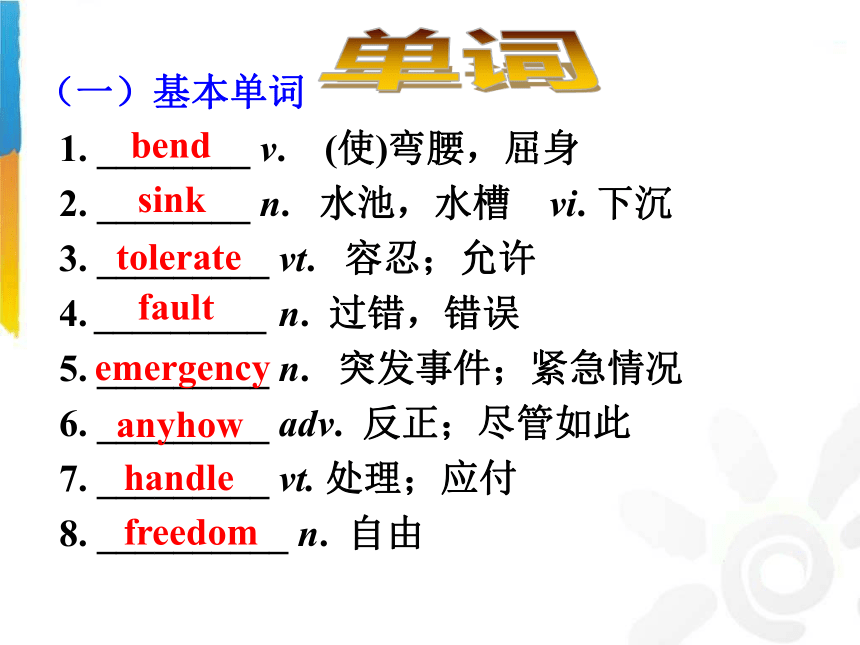
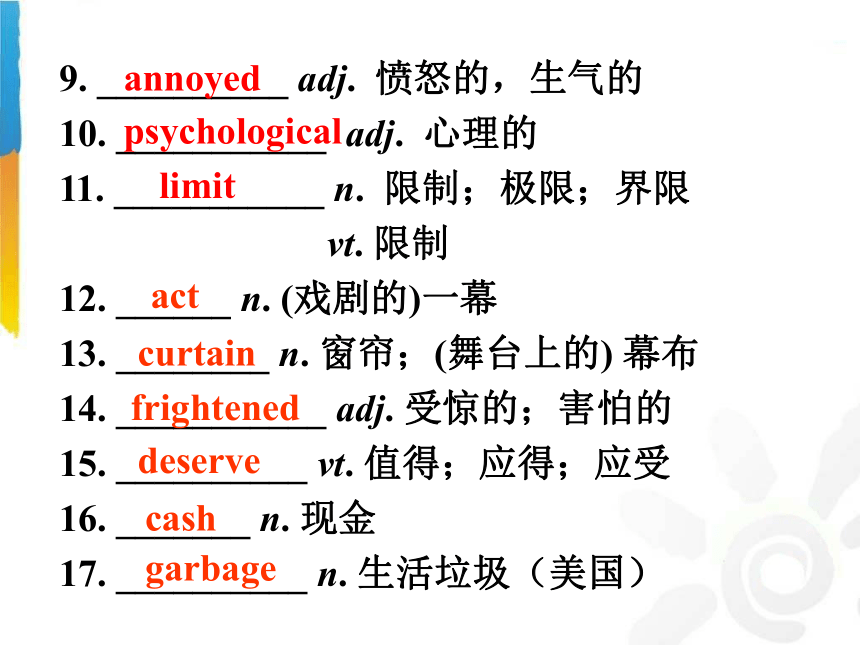
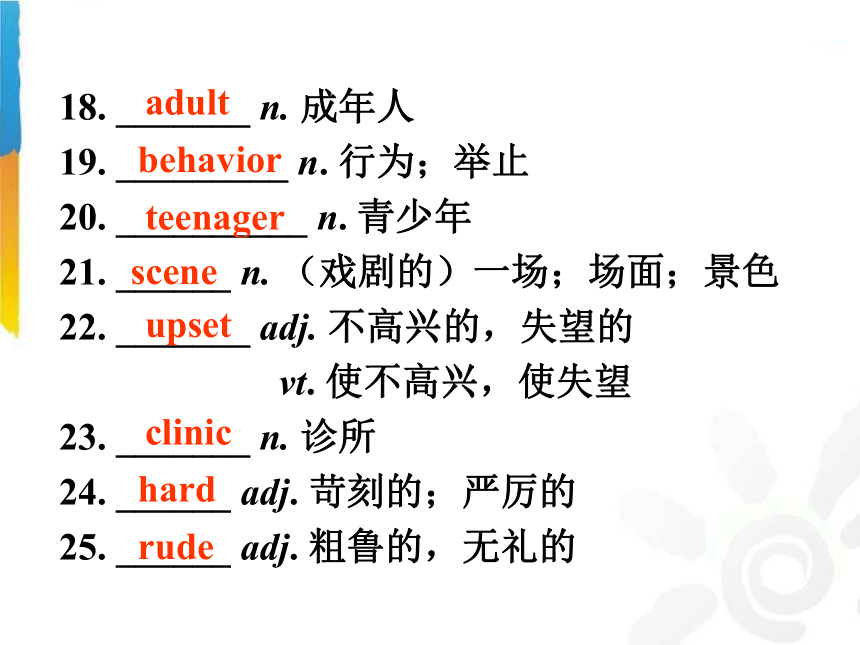
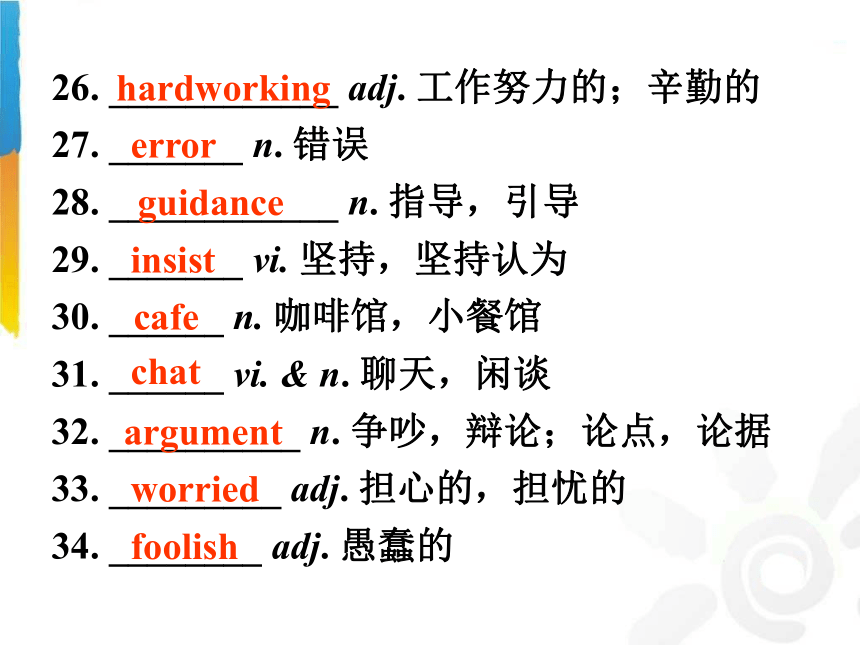
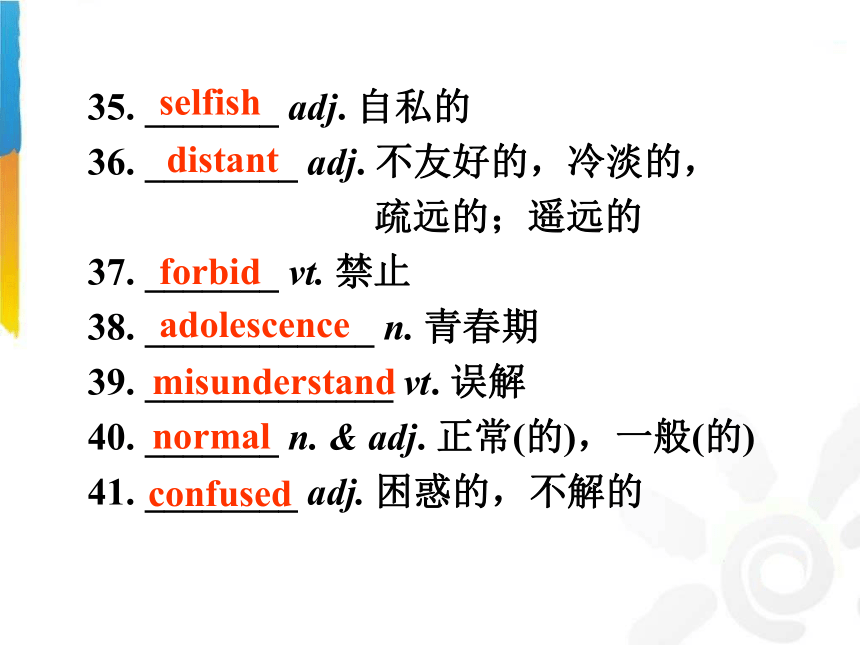
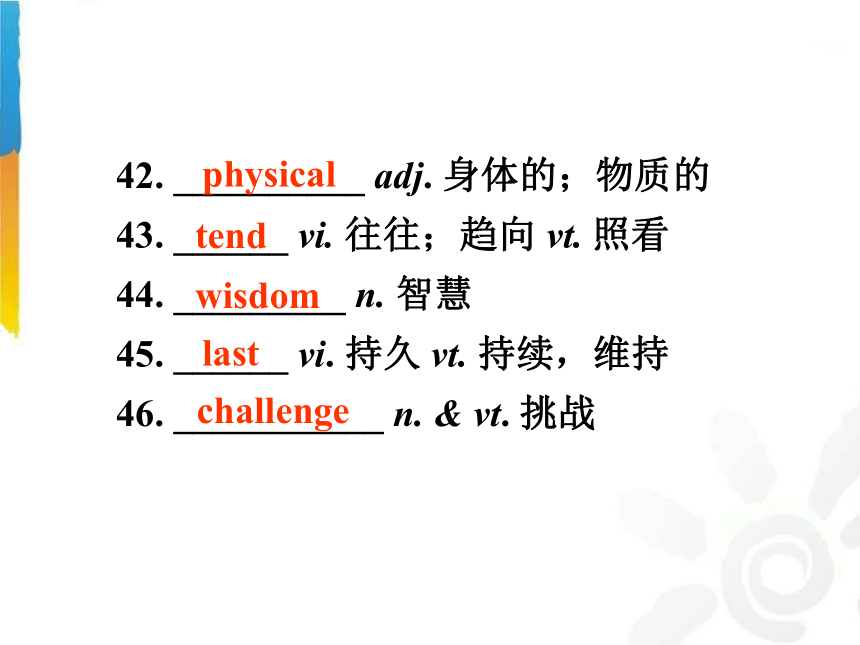
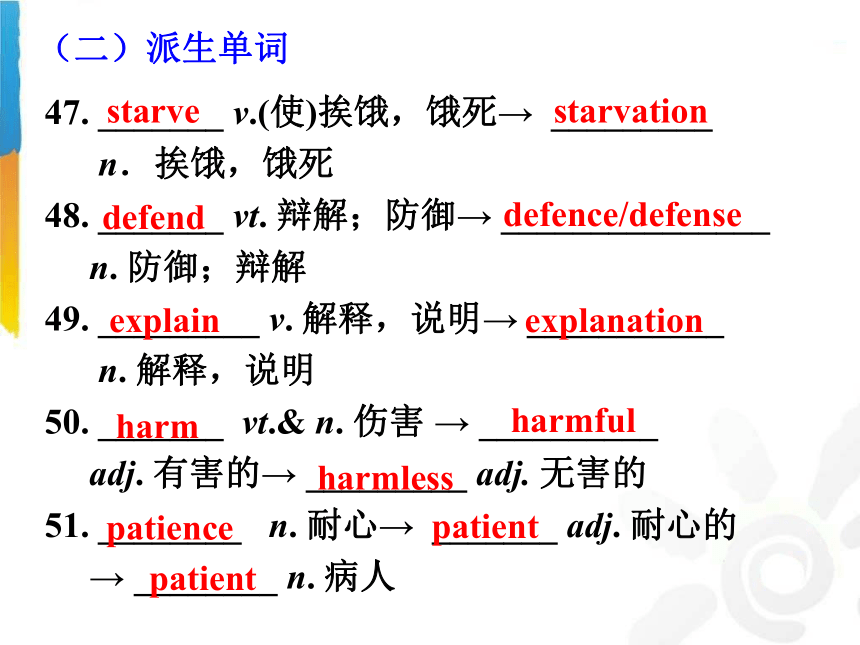
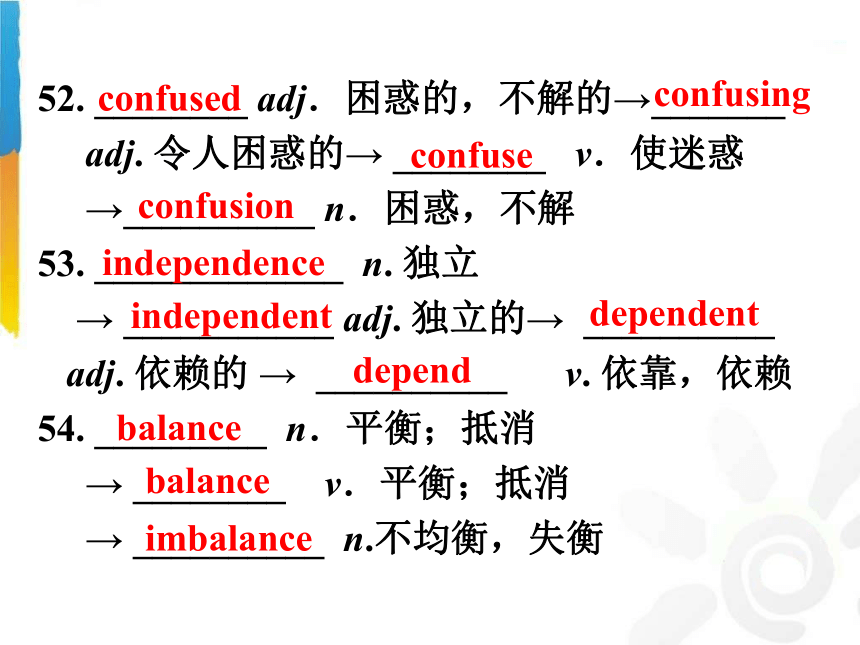


文档简介
课件52张PPT。Unit 2 Growing pains知识清单1. ________ v. (使)弯腰,屈身
2. ________ n. 水池,水槽 vi. 下沉
3. _________ vt. 容忍;允许
4. _________ n. 过错,错误
5. _________ n. 突发事件;紧急情况
6. _________ adv. 反正;尽管如此
7. _________ vt. 处理;应付
8. __________ n. 自由bend sinktoleratefaultemergencyanyhowhandlefreedom单词(一)基本单词9. __________ adj. 愤怒的,生气的
10. ___________ adj. 心理的
11. ___________ n. 限制;极限;界限
vt. 限制
12. ______ n. (戏剧的)一幕
13. ________ n. 窗帘;(舞台上的) 幕布
14. ___________ adj. 受惊的;害怕的
15. __________ vt. 值得;应得;应受
16. _______ n. 现金
17. __________ n. 生活垃圾(美国)annoyedpsychologicallimitactcurtainfrighteneddeservecashgarbage18. _______ n. 成年人
19. _________ n. 行为;举止
20. __________ n. 青少年
21. ______ n. (戏剧的)一场;场面;景色
22. _______ adj. 不高兴的,失望的
vt. 使不高兴,使失望
23. _______ n. 诊所
24. ______ adj. 苛刻的;严厉的
25. ______ adj. 粗鲁的,无礼的adultbehaviorteenagersceneupsetclinichardrude26. ____________ adj. 工作努力的;辛勤的
27. _______ n. 错误
28. ____________ n. 指导,引导
29. _______ vi. 坚持,坚持认为
30. ______ n. 咖啡馆,小餐馆
31. ______ vi. & n. 聊天,闲谈
32. __________ n. 争吵,辩论;论点,论据
33. _________ adj. 担心的,担忧的
34. ________ adj. 愚蠢的hardworkingerrorguidanceinsistcafechatargumentworriedfoolish35. _______ adj. 自私的
36. ________ adj. 不友好的,冷淡的,
疏远的;遥远的
37. _______ vt. 禁止
38. ____________ n. 青春期
39. _____________ vt. 误解
40. _______ n. & adj. 正常(的),一般(的)
41. ________ adj. 困惑的,不解的selfishdistantforbidadolescencemisunderstandnormalconfused42. __________ adj. 身体的;物质的
43. ______ vi. 往往;趋向 vt. 照看
44. _________ n. 智慧
45. ______ vi. 持久 vt. 持续,维持
46. ___________ n. & vt. 挑战physicaltendwisdomlastchallenge47. _______ v.(使)挨饿,饿死→ _________
n.挨饿,饿死
48. _______ vt. 辩解;防御→ _______________
n. 防御;辩解
49. _________ v. 解释,说明→ ___________
n. 解释,说明
50. _______ vt.& n. 伤害 → __________
adj. 有害的→ _________ adj. 无害的
51. ________ n. 耐心→ _______ adj. 耐心的
→ ________ n. 病人defend defence/defenseexplainexplanationstarvestarvationharmharmfulpatiencepatientpatientharmless(二)派生单词52. ________ adj.困惑的,不解的→_______
adj. 令人困惑的→ ________ v.使迷惑
→__________ n.困惑,不解
53. _____________ n. 独立
→ ___________ adj. 独立的→ __________
adj. 依赖的 → __________ v. 依靠,依赖
54. _________ n.平衡;抵消
→ ________ v.平衡;抵消
→ __________ n.不均衡,失衡confusedconfusingconfuseindependencebalancebalanceimbalanceindependentdependentdependconfusion1. 从……回来 ____________________
2. 在某人身上发生 ____________________
3. 迫不及待地要做某事 ____________________
4. 处理,对待 ____________________
5. 留下某人负责 ____________________
6. 一个做某事的机会 ____________________
7. 停电,熄灯 ____________________
8. 没时间做某事 ____________________
9. 对某人大声嚷嚷 ____________________
10. 注定要做,一定将做某事 ____________ arrive back frombe to do sth.shout at sb.have no time to do sth.go outa chance to do sth.leave sb. in chargedo with can’t wait to do sth.happen to sb.短语11. 花时间做某事 _______________
12. 对某人要求严格,苛刻 _______________
13. 既然 _______________
14. 感觉像 _______________
15. 以……的形式 _______________
16. 注意 _______________
17. 经历;经受 _______________
18. 似乎 _______________
19. 一天天(变化) _______________
20. 失控 _______________spend time doing sth.
be too hard on sb.
now that
feel like
in the form of
pay attention to
go through
as if
day by day
out of control21. 有这种感受 __________________
22. 此刻 __________________
23. 被认为是 __________________
24. 对……变得迷惑 __________________
25. 趋向于 __________________
26. 在这一方面 __________________
27. 做出好的选择 __________________
28. 与此同时 __________________
29. 依靠 __________________
30. 结果是 __________________
31. 应该做某事 __________________feel this way
right now
be thought of as
become confused with
tend to
in this regard
make good choices
at the same time
depend on
turn out
be supposed to do核心要点【拓展】
challenging adj.具有挑战性的,引起争论
的,不赞同的1. challenge n.挑战,艰巨的工作
vt. 怀疑,向……挑战,公然对抗
/反抗【归纳】
beyond challenge 无可非难,无与伦比
challenge sb. 向某人挑战单词【拓展】
explain vt. 解释,说明;为……辩解
explain 不能接双宾语,不能说,explain sb. sth.,应该说explain sth. to sb.=explain to sb. sth.,意为“向……解释……”。2. explanation n. 解释,说明【归纳】
explanation of/for 为……做说明,解释3. harm n.伤害,损害 vt. 损害,伤害;危害【归纳】
do sb./sth. harm = do harm to sb./sth. 对……有害
mean no harm 没有恶意【拓展】
1) annoy vt. 使烦恼;使为难;打搅
annoy sb. with sth./by doing sth.
因(做)某事而惹某人生气或烦恼
2) annoying adj. 令人烦恼的4. annoyed adj. 愤怒的,生气的【归纳】
be annoyed with sb. about/at/for sth.
因……而生某人的气5. normal adj.标准的,正规的,正常的
n.正常【归纳】
return to normal= get back to normal
恢复正常
【拓展】abnormal adj. 不正常的 区别common, usual, ordinary, general与regular
(1)common 意思是“常见的,普遍的”,指司空见惯的,不显赫的或不特别的;既可修饰人也可修饰物。例如:
They can treat most common diseases.
他们能治疗大多数的常见病。
(2)ordinary 意思是“平凡的”,是依照一定的标准来判断,因此有“平淡无奇”的意思。例如:
I’m an ordinary woman.
我是一位普通妇女。辨析(3)general 意思是“较少例外”,含“普及,大众化,多数”的意思。例如:
Surfing the Internet has become general.
上网已变得普遍。
(4)usual 意思是“通常,往常”,指由于长时间没有变化而形成的一种习惯或制度。例如:
It’s usual with her to go to school by bus.
她习惯搭公交车去上学。
(5)regular 意思是“有规律的,定期的”。例如:
Regular exercise does good to our health.
有规律的锻炼对我们的身体有好处。【归纳】
adj.[同]心烦的 annoyed, bothered
vt.[同]打搅 annoy, bother
be upset by/about/at 为……感到苦恼
upset that…为……感到苦恼
be upset with sb.生某人的气
=be angry/annoyed with sb.
【拓展】upsetting adj.令人心烦的6. upset adj. 心烦的,苦恼的 vt. 使心烦7. insist vt. & vi. 坚持主张; 坚持认为 【归纳】
insist on sth. 主张,坚持于某事
insist on (sb./ sb’s) doing sth.
坚持(要某人)做某事
insist that sb./sth. (should) do sth.
insist 后接虚拟语气,坚持要求……区别insist on, stick to与persist in
(1) insist on 意为“坚持意见、主张”。
(2) stick to 意为“坚持决定、计划、真理、 诺言、原则”。
(3) persist in 意为“坚持行动”,有时也可表示固执己见或坚决不改。辨析8. deserve v. 值得;应得;应受【归纳】
(1) deserve +
n. (consideration/sympathy/attention)
值得……(考虑/同情/注意)
(2) deserve to do sth. 值得做某事
(do与主语之间为主动关系)
(3) deserve doing/to be done 值得被做
(do与主语之间为被动关系)deserve doing是主动形式表示被动含义。
类似的常用词还有:need, want, require等。如:这台电视机需要修理一下。
We need to have the TV mended.
The TV needs mending/ to be mended.Tip1. go through 经历;仔细检查【拓展go的常用短语】
go over 复习
go against 违背,反对
go off = go out 熄灭
go without 不吃,不用
go ahead (表同意)开始做吧短语2. be supposed to do 应该做某事;应当……【拓展】
1) be supposed to have done 本应做……
=was/were supposed to do
2) suppose sb. to be … 认为某人是……
3) I don’t suppose (that) …
我认为……不……(否定转移)
4) What do you suppose + 陈述句?
你认为……?(插入语)
5) suppose/supposing (that)…
(条件状语从句)假设……3. turn out 结果是,原来是;生产,制造【归纳】
turn out (to be) + adj./n.
It turns out that … 原来/结果是……【拓展turn 的常用短语】
turn on 打开……的开关
turn off 关闭(开关)
turn down 关小(开关);拒绝(请求,邀请等)
turn up 调大(开关);出现,露面,发生
turn to 求助于;转向
turn over 转交;移交;翻转4. along with 与……一起,除了……以外along with 连接主语时,谓语与前面的主语
保持一致。此外还有 as well as,with,
together with,besides,except,but,
including,rather than, such as 等引导的短
语,都不作主语,因此谓语要与真正的主语
保持一致。如:
I sent them my order, along with a cheque for
£40.
我把订单连同一张40英镑的支票一起寄给了
他们。1. The room is in a mess, with pizza boxes on
the floor and dirty dishes in the sink. with + 宾语 + 宾语补足语 【归纳】
with + n./pron. + adj./adv.
doing (主动)
done (完成及被动)
to do (动作为发生)
prep. 短语句式“with+复合宾语”的常见结构有以下几种:
(1)with+名词/代词+分词(现在分词/过去分词)
The old man lay on the grass, with his eyes looking at the sky.
老人躺在草地上,眼睛望着天空。
(2)with+名词/代词+形容词
With the weather so stuffy, it’s sure to rain.
天气如此闷热,肯定要下雨。(3)with+名词/代词+副词
They sat in silence with the light on for half an hour.
他们开着灯一声不吭地坐了半小时。
(4)with+名词/代词+介词短语
The boss stood there with his hands in his pockets.
老板站在那里,双手插在口袋里。
(5)with+名词/代词+不定式
With nothing to chat, I felt bored.
因为没什么东西可聊,我感到很无趣。2. Maybe, but now that he has been so rude
to us, I feel like we have to punish him or
he won’t respect us.now that sb. does
此句型意为“因为/既然……”。now that 是连词,that 可省略,相当于 since(因为)或 seeing (that)(既然),引导状语从句,修饰主句。与that搭配且后面可以加句子的几个表达形
式:
now that 既然,由于; in that 因为;
except that 除……之外。
except后面加名词或代词;
except that后面加句子。
3. We didn’t think you would let the house get
so dirty. I don’t think (that)…
如果否定的是后面的宾语从句,通常是将否定词提前移到主句中去,其意义仍然是表示否定后面的部分。像 I think,I believe,I suppose,I imagine 等词语引出否定的从句时,大多是将 not 放在主句谓语部分。在口语中,尤其是这样。【注意】 陈述部分主句为第一人称,谓语是think, believe, expect, suppose, imagine等,后面为宾语从句时,疑问部分与宾语从句相对应构成反意疑问句。例如:
I don’t think he is bright, is he?
我认为他并不聪明,是吗?
说明:此句另一个难点是“否定迁移”。如:
We believe she can do it better, can’t she?
我们相信她能做得更好,她能吗? 4. I still wish we could go to the cinema
tomorrow though!I wish + (that) + 主语 + 动词过去式/过去完成式 (had+过去分词) ……
I wish 之后以 that 从句为宾语时,该从句的谓语动词一定要用虚拟语气:若动词用过去式,表示与现在事实相反的愿望;若用过去完成式,则表示与过去事实相反的愿望。“I wish + that从句”的句型也可用“I would
rather + that从句”取代。
而 I hope 之后以 that 从句作宾语时,该从句
用一般时态。如:
I wish I had known you ten years ago.
真希望十年前就认识你了。
【注意】该虚拟语气句型的难点在于:
用“过去式(did / were)”,还是用“过去完成式(had done)”。5. Daniel has his arms crossed and looks upset.
have sth. done是常用结构,have是使役动词,his arms和cross构成被动关系。【归纳have 的常用句型】
have sb. do 让某人做某事
have sb. doing 让某人一直做某事(强调持续性)
have sth. done 使……被做;有某种遭遇或经历
can’t/won’t/have sb. doing 不能容忍/容许某人做……
have sth. to do 有某事要做6. Along with these physical changes, there come
many psychological changes. 此句there置于句首的________句。主语为_________。倒装changes地点副词 here,there 位于句首时,若主语是名词,主谓须完全倒装(谓语动词全部放在主语前面)。There’s an outdoor concert tonight in our school.
Here are some books donated by the students
of our school to those who are living in the mountains. 若主语是代词,主谓不倒装。
2) 一般不使用进行时态。
—Look, here comes the bus.
—Oh, here it comes.
(用一般现在时替代现在进行时)Tip1. The guard at the gate insisted that everybody
________ the rules.
A. obeys B. obey
C. will obey D. would obey
2. The man insisted ________ a taxi for me even though I told him I lived nearby.
A. find B. to find
C. on finding D. in finding巩固练习3. All the employees except the manager
______ to work online at home.
A.encourages
B.encourage
C.is encouraged
D.are encouraged4. He was not the type to deliberately _____
his child.
A. destroy B. damage
C. harm D. injure5. The father _____ was ______ to find his son playing with his favourite bird.
A. annoyed; surprising
B. annoyed; surprised
C. annoying; surprised
D. annoying; surprising6. —Can I use this expression in the text?
—No. It has ______. Nobody uses it today.
A. given up B. broken down
C. gone out D. got off
7. He came into the classroom, ______.
A. very upset B. being upset
C. upset very D. to be upset8. John opened the door. There _____ he had
never seen before.
A. a girl did stand B. a girl stood
C. did a girl stand D. stood a girl
9. — Is everyone here?
— Not yet …. Look, there _______ the rest
of our guests!
A. come B. comes
C. is coming D. are coming10. —Do you have any clothes _____, sir?
—No, thank you. A. to wash B. to washing
C. to be washing D. to be washed
11. —Did Peter fix the computer himself? —He ______, because he doesn’t know
much about computers. A. has it fixed B. had fixed it
C. had it fixed D. fixed it 12. Finding information in today’s world is easy.
The _____ is how you can tell if the
information you get is useful or not.
A. ability B. competition
C. challenge D. knowledge13. The teacher said he would ____ next time.
A. explain us the text
B. explain us to the text
C. explain the text to us
D. explain the text us14. The living room is clean and tidy, with a
dining table already ____ for a meal to
be cooked. (2010·山东)
A. laid B. laying
C. to lay D. being laid15. ____ we have finished the course, we
shall start doing more revision work.
A. For now B. Now that
C. Ever since D. By now16. William wishes now that he _____ English
instead of French when he was in high
school.
A. should have studied
B. should study
C. studied
D. had studied
2. ________ n. 水池,水槽 vi. 下沉
3. _________ vt. 容忍;允许
4. _________ n. 过错,错误
5. _________ n. 突发事件;紧急情况
6. _________ adv. 反正;尽管如此
7. _________ vt. 处理;应付
8. __________ n. 自由bend sinktoleratefaultemergencyanyhowhandlefreedom单词(一)基本单词9. __________ adj. 愤怒的,生气的
10. ___________ adj. 心理的
11. ___________ n. 限制;极限;界限
vt. 限制
12. ______ n. (戏剧的)一幕
13. ________ n. 窗帘;(舞台上的) 幕布
14. ___________ adj. 受惊的;害怕的
15. __________ vt. 值得;应得;应受
16. _______ n. 现金
17. __________ n. 生活垃圾(美国)annoyedpsychologicallimitactcurtainfrighteneddeservecashgarbage18. _______ n. 成年人
19. _________ n. 行为;举止
20. __________ n. 青少年
21. ______ n. (戏剧的)一场;场面;景色
22. _______ adj. 不高兴的,失望的
vt. 使不高兴,使失望
23. _______ n. 诊所
24. ______ adj. 苛刻的;严厉的
25. ______ adj. 粗鲁的,无礼的adultbehaviorteenagersceneupsetclinichardrude26. ____________ adj. 工作努力的;辛勤的
27. _______ n. 错误
28. ____________ n. 指导,引导
29. _______ vi. 坚持,坚持认为
30. ______ n. 咖啡馆,小餐馆
31. ______ vi. & n. 聊天,闲谈
32. __________ n. 争吵,辩论;论点,论据
33. _________ adj. 担心的,担忧的
34. ________ adj. 愚蠢的hardworkingerrorguidanceinsistcafechatargumentworriedfoolish35. _______ adj. 自私的
36. ________ adj. 不友好的,冷淡的,
疏远的;遥远的
37. _______ vt. 禁止
38. ____________ n. 青春期
39. _____________ vt. 误解
40. _______ n. & adj. 正常(的),一般(的)
41. ________ adj. 困惑的,不解的selfishdistantforbidadolescencemisunderstandnormalconfused42. __________ adj. 身体的;物质的
43. ______ vi. 往往;趋向 vt. 照看
44. _________ n. 智慧
45. ______ vi. 持久 vt. 持续,维持
46. ___________ n. & vt. 挑战physicaltendwisdomlastchallenge47. _______ v.(使)挨饿,饿死→ _________
n.挨饿,饿死
48. _______ vt. 辩解;防御→ _______________
n. 防御;辩解
49. _________ v. 解释,说明→ ___________
n. 解释,说明
50. _______ vt.& n. 伤害 → __________
adj. 有害的→ _________ adj. 无害的
51. ________ n. 耐心→ _______ adj. 耐心的
→ ________ n. 病人defend defence/defenseexplainexplanationstarvestarvationharmharmfulpatiencepatientpatientharmless(二)派生单词52. ________ adj.困惑的,不解的→_______
adj. 令人困惑的→ ________ v.使迷惑
→__________ n.困惑,不解
53. _____________ n. 独立
→ ___________ adj. 独立的→ __________
adj. 依赖的 → __________ v. 依靠,依赖
54. _________ n.平衡;抵消
→ ________ v.平衡;抵消
→ __________ n.不均衡,失衡confusedconfusingconfuseindependencebalancebalanceimbalanceindependentdependentdependconfusion1. 从……回来 ____________________
2. 在某人身上发生 ____________________
3. 迫不及待地要做某事 ____________________
4. 处理,对待 ____________________
5. 留下某人负责 ____________________
6. 一个做某事的机会 ____________________
7. 停电,熄灯 ____________________
8. 没时间做某事 ____________________
9. 对某人大声嚷嚷 ____________________
10. 注定要做,一定将做某事 ____________ arrive back frombe to do sth.shout at sb.have no time to do sth.go outa chance to do sth.leave sb. in chargedo with can’t wait to do sth.happen to sb.短语11. 花时间做某事 _______________
12. 对某人要求严格,苛刻 _______________
13. 既然 _______________
14. 感觉像 _______________
15. 以……的形式 _______________
16. 注意 _______________
17. 经历;经受 _______________
18. 似乎 _______________
19. 一天天(变化) _______________
20. 失控 _______________spend time doing sth.
be too hard on sb.
now that
feel like
in the form of
pay attention to
go through
as if
day by day
out of control21. 有这种感受 __________________
22. 此刻 __________________
23. 被认为是 __________________
24. 对……变得迷惑 __________________
25. 趋向于 __________________
26. 在这一方面 __________________
27. 做出好的选择 __________________
28. 与此同时 __________________
29. 依靠 __________________
30. 结果是 __________________
31. 应该做某事 __________________feel this way
right now
be thought of as
become confused with
tend to
in this regard
make good choices
at the same time
depend on
turn out
be supposed to do核心要点【拓展】
challenging adj.具有挑战性的,引起争论
的,不赞同的1. challenge n.挑战,艰巨的工作
vt. 怀疑,向……挑战,公然对抗
/反抗【归纳】
beyond challenge 无可非难,无与伦比
challenge sb. 向某人挑战单词【拓展】
explain vt. 解释,说明;为……辩解
explain 不能接双宾语,不能说,explain sb. sth.,应该说explain sth. to sb.=explain to sb. sth.,意为“向……解释……”。2. explanation n. 解释,说明【归纳】
explanation of/for 为……做说明,解释3. harm n.伤害,损害 vt. 损害,伤害;危害【归纳】
do sb./sth. harm = do harm to sb./sth. 对……有害
mean no harm 没有恶意【拓展】
1) annoy vt. 使烦恼;使为难;打搅
annoy sb. with sth./by doing sth.
因(做)某事而惹某人生气或烦恼
2) annoying adj. 令人烦恼的4. annoyed adj. 愤怒的,生气的【归纳】
be annoyed with sb. about/at/for sth.
因……而生某人的气5. normal adj.标准的,正规的,正常的
n.正常【归纳】
return to normal= get back to normal
恢复正常
【拓展】abnormal adj. 不正常的 区别common, usual, ordinary, general与regular
(1)common 意思是“常见的,普遍的”,指司空见惯的,不显赫的或不特别的;既可修饰人也可修饰物。例如:
They can treat most common diseases.
他们能治疗大多数的常见病。
(2)ordinary 意思是“平凡的”,是依照一定的标准来判断,因此有“平淡无奇”的意思。例如:
I’m an ordinary woman.
我是一位普通妇女。辨析(3)general 意思是“较少例外”,含“普及,大众化,多数”的意思。例如:
Surfing the Internet has become general.
上网已变得普遍。
(4)usual 意思是“通常,往常”,指由于长时间没有变化而形成的一种习惯或制度。例如:
It’s usual with her to go to school by bus.
她习惯搭公交车去上学。
(5)regular 意思是“有规律的,定期的”。例如:
Regular exercise does good to our health.
有规律的锻炼对我们的身体有好处。【归纳】
adj.[同]心烦的 annoyed, bothered
vt.[同]打搅 annoy, bother
be upset by/about/at 为……感到苦恼
upset that…为……感到苦恼
be upset with sb.生某人的气
=be angry/annoyed with sb.
【拓展】upsetting adj.令人心烦的6. upset adj. 心烦的,苦恼的 vt. 使心烦7. insist vt. & vi. 坚持主张; 坚持认为 【归纳】
insist on sth. 主张,坚持于某事
insist on (sb./ sb’s) doing sth.
坚持(要某人)做某事
insist that sb./sth. (should) do sth.
insist 后接虚拟语气,坚持要求……区别insist on, stick to与persist in
(1) insist on 意为“坚持意见、主张”。
(2) stick to 意为“坚持决定、计划、真理、 诺言、原则”。
(3) persist in 意为“坚持行动”,有时也可表示固执己见或坚决不改。辨析8. deserve v. 值得;应得;应受【归纳】
(1) deserve +
n. (consideration/sympathy/attention)
值得……(考虑/同情/注意)
(2) deserve to do sth. 值得做某事
(do与主语之间为主动关系)
(3) deserve doing/to be done 值得被做
(do与主语之间为被动关系)deserve doing是主动形式表示被动含义。
类似的常用词还有:need, want, require等。如:这台电视机需要修理一下。
We need to have the TV mended.
The TV needs mending/ to be mended.Tip1. go through 经历;仔细检查【拓展go的常用短语】
go over 复习
go against 违背,反对
go off = go out 熄灭
go without 不吃,不用
go ahead (表同意)开始做吧短语2. be supposed to do 应该做某事;应当……【拓展】
1) be supposed to have done 本应做……
=was/were supposed to do
2) suppose sb. to be … 认为某人是……
3) I don’t suppose (that) …
我认为……不……(否定转移)
4) What do you suppose + 陈述句?
你认为……?(插入语)
5) suppose/supposing (that)…
(条件状语从句)假设……3. turn out 结果是,原来是;生产,制造【归纳】
turn out (to be) + adj./n.
It turns out that … 原来/结果是……【拓展turn 的常用短语】
turn on 打开……的开关
turn off 关闭(开关)
turn down 关小(开关);拒绝(请求,邀请等)
turn up 调大(开关);出现,露面,发生
turn to 求助于;转向
turn over 转交;移交;翻转4. along with 与……一起,除了……以外along with 连接主语时,谓语与前面的主语
保持一致。此外还有 as well as,with,
together with,besides,except,but,
including,rather than, such as 等引导的短
语,都不作主语,因此谓语要与真正的主语
保持一致。如:
I sent them my order, along with a cheque for
£40.
我把订单连同一张40英镑的支票一起寄给了
他们。1. The room is in a mess, with pizza boxes on
the floor and dirty dishes in the sink. with + 宾语 + 宾语补足语 【归纳】
with + n./pron. + adj./adv.
doing (主动)
done (完成及被动)
to do (动作为发生)
prep. 短语句式“with+复合宾语”的常见结构有以下几种:
(1)with+名词/代词+分词(现在分词/过去分词)
The old man lay on the grass, with his eyes looking at the sky.
老人躺在草地上,眼睛望着天空。
(2)with+名词/代词+形容词
With the weather so stuffy, it’s sure to rain.
天气如此闷热,肯定要下雨。(3)with+名词/代词+副词
They sat in silence with the light on for half an hour.
他们开着灯一声不吭地坐了半小时。
(4)with+名词/代词+介词短语
The boss stood there with his hands in his pockets.
老板站在那里,双手插在口袋里。
(5)with+名词/代词+不定式
With nothing to chat, I felt bored.
因为没什么东西可聊,我感到很无趣。2. Maybe, but now that he has been so rude
to us, I feel like we have to punish him or
he won’t respect us.now that sb. does
此句型意为“因为/既然……”。now that 是连词,that 可省略,相当于 since(因为)或 seeing (that)(既然),引导状语从句,修饰主句。与that搭配且后面可以加句子的几个表达形
式:
now that 既然,由于; in that 因为;
except that 除……之外。
except后面加名词或代词;
except that后面加句子。
3. We didn’t think you would let the house get
so dirty. I don’t think (that)…
如果否定的是后面的宾语从句,通常是将否定词提前移到主句中去,其意义仍然是表示否定后面的部分。像 I think,I believe,I suppose,I imagine 等词语引出否定的从句时,大多是将 not 放在主句谓语部分。在口语中,尤其是这样。【注意】 陈述部分主句为第一人称,谓语是think, believe, expect, suppose, imagine等,后面为宾语从句时,疑问部分与宾语从句相对应构成反意疑问句。例如:
I don’t think he is bright, is he?
我认为他并不聪明,是吗?
说明:此句另一个难点是“否定迁移”。如:
We believe she can do it better, can’t she?
我们相信她能做得更好,她能吗? 4. I still wish we could go to the cinema
tomorrow though!I wish + (that) + 主语 + 动词过去式/过去完成式 (had+过去分词) ……
I wish 之后以 that 从句为宾语时,该从句的谓语动词一定要用虚拟语气:若动词用过去式,表示与现在事实相反的愿望;若用过去完成式,则表示与过去事实相反的愿望。“I wish + that从句”的句型也可用“I would
rather + that从句”取代。
而 I hope 之后以 that 从句作宾语时,该从句
用一般时态。如:
I wish I had known you ten years ago.
真希望十年前就认识你了。
【注意】该虚拟语气句型的难点在于:
用“过去式(did / were)”,还是用“过去完成式(had done)”。5. Daniel has his arms crossed and looks upset.
have sth. done是常用结构,have是使役动词,his arms和cross构成被动关系。【归纳have 的常用句型】
have sb. do 让某人做某事
have sb. doing 让某人一直做某事(强调持续性)
have sth. done 使……被做;有某种遭遇或经历
can’t/won’t/have sb. doing 不能容忍/容许某人做……
have sth. to do 有某事要做6. Along with these physical changes, there come
many psychological changes. 此句there置于句首的________句。主语为_________。倒装changes地点副词 here,there 位于句首时,若主语是名词,主谓须完全倒装(谓语动词全部放在主语前面)。There’s an outdoor concert tonight in our school.
Here are some books donated by the students
of our school to those who are living in the mountains. 若主语是代词,主谓不倒装。
2) 一般不使用进行时态。
—Look, here comes the bus.
—Oh, here it comes.
(用一般现在时替代现在进行时)Tip1. The guard at the gate insisted that everybody
________ the rules.
A. obeys B. obey
C. will obey D. would obey
2. The man insisted ________ a taxi for me even though I told him I lived nearby.
A. find B. to find
C. on finding D. in finding巩固练习3. All the employees except the manager
______ to work online at home.
A.encourages
B.encourage
C.is encouraged
D.are encouraged4. He was not the type to deliberately _____
his child.
A. destroy B. damage
C. harm D. injure5. The father _____ was ______ to find his son playing with his favourite bird.
A. annoyed; surprising
B. annoyed; surprised
C. annoying; surprised
D. annoying; surprising6. —Can I use this expression in the text?
—No. It has ______. Nobody uses it today.
A. given up B. broken down
C. gone out D. got off
7. He came into the classroom, ______.
A. very upset B. being upset
C. upset very D. to be upset8. John opened the door. There _____ he had
never seen before.
A. a girl did stand B. a girl stood
C. did a girl stand D. stood a girl
9. — Is everyone here?
— Not yet …. Look, there _______ the rest
of our guests!
A. come B. comes
C. is coming D. are coming10. —Do you have any clothes _____, sir?
—No, thank you. A. to wash B. to washing
C. to be washing D. to be washed
11. —Did Peter fix the computer himself? —He ______, because he doesn’t know
much about computers. A. has it fixed B. had fixed it
C. had it fixed D. fixed it 12. Finding information in today’s world is easy.
The _____ is how you can tell if the
information you get is useful or not.
A. ability B. competition
C. challenge D. knowledge13. The teacher said he would ____ next time.
A. explain us the text
B. explain us to the text
C. explain the text to us
D. explain the text us14. The living room is clean and tidy, with a
dining table already ____ for a meal to
be cooked. (2010·山东)
A. laid B. laying
C. to lay D. being laid15. ____ we have finished the course, we
shall start doing more revision work.
A. For now B. Now that
C. Ever since D. By now16. William wishes now that he _____ English
instead of French when he was in high
school.
A. should have studied
B. should study
C. studied
D. had studied
